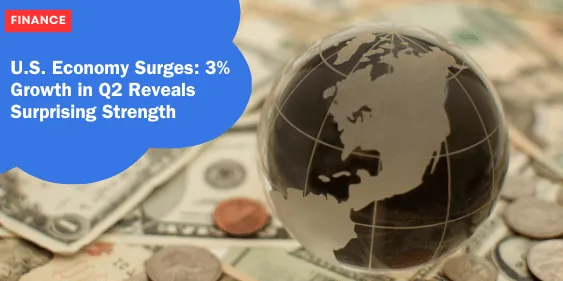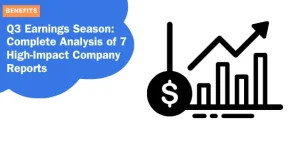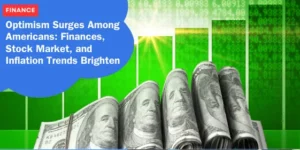U.S. Economy Surges: 3% Growth in Q2 Reveals Surprising Strength

The U.S. economy showed remarkable strength in the second quarter, with GDP growth revised from an initial estimate of 2.8% to an impressive 3%.
This upward adjustment highlights a robust economic climate that continues to defy expectations.
Revision of Figures and Key Drivers
The revised 3% GDP growth was significantly fueled by a 2.9% increase in personal spending.
Consumers ramping up their expenditures played a pivotal role in driving economic activity.
Given that GDP is the most comprehensive measure of economic activity, capturing consumption, investment, government spending, and trade, these figures illustrate the remarkable resilience of the U.S. economy.
Context of Economic Resilience
Despite contending with inflation levels higher than the Federal Reserve’s 2% target, the economy demonstrated robust resilience.
This adaptability is characterized by sustained spending and stable unemployment claims.
Even with inflation remaining a significant concern, the economy continues to surge ahead, bolstered by strong consumer activity.
Implications for Future Trends
The positive momentum seen in Q2 sets a solid foundation for future economic performance.
While personal spending has driven much of the growth, it also sets the stage for further economic activities across various sectors.
This focus on consumer behavior as a growth driver suggests that if personal spending remains strong, the economy is likely to maintain its upward trajectory.
The Q2 growth figures provide a critical insight into the underlying strength of the U.S. economy.
As we look ahead, these insights will be vital in understanding how various factors, such as inflation and unemployment, will shape future economic performance.
Indicators of Economic Resilience
The U.S. economy has shown remarkable resilience in the face of various challenges.
Even though inflation remains higher than the Federal Reserve’s target of 2%, the economy continues to grow, dismissing concerns of an imminent recession.
Steady Inflation but Economic Growth
Inflation rates have been a central concern, consistently staying above the Fed’s 2% target.
This persistency stirs debates on the trajectory of monetary policy but hasn’t slowed down economic activities.
Recent data reflects a robust economy growing at adjusted rates, bolstered significantly by consumer spending.
Unemployment Claims: A Sign of Stability
Despite inflationary pressures, the stability in unemployment claims is a reassuring sign.
The latest data indicates that layoffs have remained subdued, even as firms cope with rising costs.
This stability in the labor market is crucial, as it reflects ongoing confidence among businesses and employees alike.
While the economy contends with higher inflation, stable unemployment rates suggest underlying strengths.
This duality of challenges and strong economic indicators presents a promising yet complex outlook.
High inflation and stable jobless claims represent the nuanced nature of the current economic climate, setting the stage for discussions on financial confidence and consumer behaviors.
Market Reactions and Federal Reserve Expectations
The recent upward revision in GDP growth inevitably caught the eye of investors everywhere, prompting a positive reaction among stock market indexes.
This surge in economic data led to markets opening on a high note, reflecting a new wave of optimism about the current state of the U.S. economy.
Stock Market Reactions
As soon as the news broke, stock markets responded with enthusiasm.
The initial readings indicating a 2.8% growth rate were promising, but the revised figure of 3% only added fuel to the bullish sentiment.
Investors interpreted this as a sign of economic resilience, bolstering confidence across various sectors.
Notably, stocks in consumer-facing industries saw notable gains, mirroring the increased personal spending.
Federal Reserve Expectations
The revised GDP numbers have also shifted expectations regarding the Federal Reserve’s monetary policy.
Initially, there was considerable speculation about a drastic cut in interest rates, as much as 50 basis points.
However, the latest economic data tempered such projections. Understanding the current economic strength, market participants now expect more measured rate cuts.
A Balanced Approach
Harvard economist Jason Furman emphasized that while the economy is exhibiting robust health, especially within the household sector, the Federal Reserve is likely to adopt a cautious, balanced approach.
Furman projects a modest yet positive GDP growth of around 2% for Q3, further supporting the case for less aggressive monetary interventions.
Economic Outlook
Despite rising unemployment, the overall economic outlook remains optimistic, driven by steady growth and a decrease in inflationary pressures.
This nuanced perspective offers a more balanced view of the economic landscape, mitigating fears of rapid downturns while acknowledging existing challenges.
As we look ahead, these developments set the stage for a deeper understanding of consumer sentiment, providing a holistic view of the U.S.
Economy’s resilience and areas of concern.
Expert Analysis and Projections
Harvard economist Jason Furman has provided insights into the surging U.S. economy.
He highlights that the real economy and the household sector exhibit robust strength.
The revised GDP growth figure of 3% in Q2 is particularly optimistic, showing few signs of a downturn in the first half of the year.
This upward revision from 2.8% can be attributed mostly to an increase in personal spending, which climbed by 2.9%.
A Strong Economy
Furman observes that the 3% growth indicates a very strong real economy.
He notes that the resilience is supported by the household sector’s solid performance.
Despite headwinds like persistent inflation, which remains above the Federal Reserve’s 2% target, the economy seems to be navigating through these challenges effectively.
Additionally, unemployment claims have remained stable, suggesting that the labor market continues to adapt well despite inflationary pressures.
GDP Projections for Q3
Looking forward, Furman projects a more moderate but still healthy GDP growth of around 2% for Q3.
This estimate takes into account the positive performance of the real economy and the continuing strength in personal spending.
These factors collectively suggest that the U.S. economy is on a stable trajectory, although some caution is warranted given the broader global uncertainties and domestic inflationary trends.
Overall Economic Outlook
Despite certain challenges, the overall economic outlook remains optimistic.
Furman points out that the economy “is looking in fine shape overall.”
Furthermore, he notes that forward-looking business sentiment appears very positive, which bodes well for continued economic growth and stability.
Inflation rates, although still above target, have shown signs of deceleration, which could offer some relief in the near future.
Transitioning from this detailed economist analysis, we can see how different sectors and income groups are experiencing this economic climate.
Mixed Consumer Sentiment
Parity in Perceptions
The U.S. economy’s recent boom has generated mixed feelings among consumers.
An equal share of Americans describe their current financial situations as “good” as those who refer to them as “bad,” according to the Conference Board’s latest consumer sentiment survey.
This divide highlights a stark reality: not all are benefiting uniformly from economic gains.
While the economy’s overall health appears robust, the contrast in consumer perspectives underscores varying financial experiences across the nation.
Confidence Levels
Consumer confidence remains below pre-pandemic levels, suggesting a lingering cautiousness among many households.
This subdued confidence has cascading effects on spending behaviors, with some consumers tightening their belts while others continue to spend.
The economic uncertainty touches various income groups differently, highlighting the unequal distribution of financial security.
Economic Disparities
Different income groups feel the impacts of the economic environment in distinct ways.
Lower-income individuals often face financial constraints, as seen in reports from Dollar General, which noted challenges due to “financially constrained” consumers.
On the other hand, higher-income households may feel more secure and willing to spend on big-ticket items.
For example, Best Buy has adjusted its fiscal outlook positively, crediting consumer interest in high-value technology products.
Despite an optimistic overall economic outlook, these mixed sentiments among consumers reflect the nuanced reality of economic resilience and growth.
Corporate Performance Insights
Dollar General’s Challenges and Consumer Struggles
Dollar General is feeling the pinch of economically constrained consumers.
In its latest earnings report, the company highlighted that financial struggles among its customer base contributed to disappointing results.
This led to a drop in stock prices. Financial hardship is a reality for many American households, and Dollar General’s performance serves as a stark reminder.
Best Buy’s Optimistic Outlook
In contrast, Best Buy has an optimistic outlook.
The retail giant adjusted its fiscal year guidance upwards, signaling confidence in the continued willingness of consumers to spend on high-priced technology.
Best Buy’s CEO, Corie Barry, noted that consumers are on the lookout for value deals but are still willing to invest in premium products, especially when new technology makes a compelling case.
Consumer Trends: Seeking Value and Technology
Consumers are navigating between budget constraints and the allure of cutting-edge technology.
While they are budget-conscious, particularly amidst sales events, they also show a readiness to invest in high-ticket items they deem necessary.
Best Buy’s improved outlook exemplifies this duality, capturing an essential dynamic in consumer behavior.
These insights from Dollar General and Best Buy highlight contrasting experiences within the retail sector, reflecting the broader economic landscape that continues to evolve.






